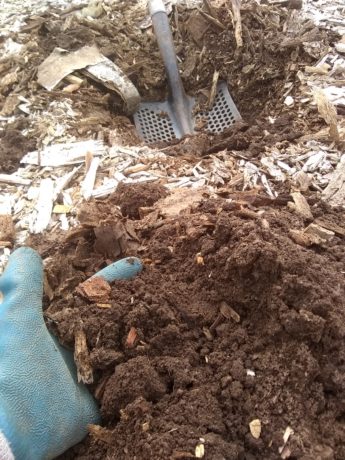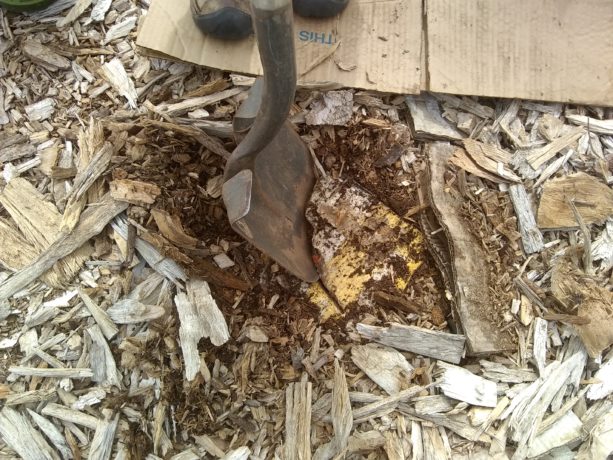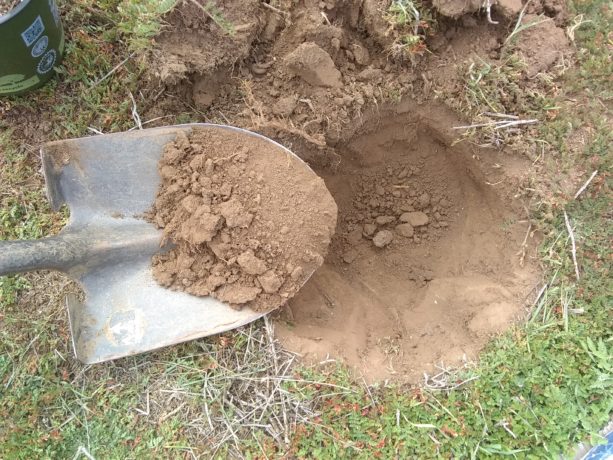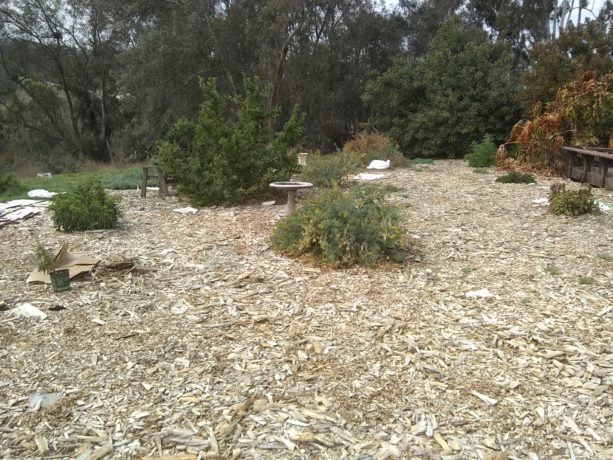What a Difference Mulch Makes
 Two years ago friend sheet-mulched her very hard, dry dirt yard using cardboard and newspaper topped with very large chunk free wood chips. Last year into this were planted a scattering of California native plants. Most of them have thrived, even surviving a frost and many 100F + days. These have been minimally watered. This week in March, after very low seasonal rainfall, we set off to plant more natives. What we found under the mulch was amazing. That light brown dirt was now moist, worm-filled soil. Under what was left of the cardboard were beautiful fungal hyphae breaking down the under layer of bark chunks into a fine surface compost. The shovel slide through the newspaper and into the ground making for very easy digging.
Two years ago friend sheet-mulched her very hard, dry dirt yard using cardboard and newspaper topped with very large chunk free wood chips. Last year into this were planted a scattering of California native plants. Most of them have thrived, even surviving a frost and many 100F + days. These have been minimally watered. This week in March, after very low seasonal rainfall, we set off to plant more natives. What we found under the mulch was amazing. That light brown dirt was now moist, worm-filled soil. Under what was left of the cardboard were beautiful fungal hyphae breaking down the under layer of bark chunks into a fine surface compost. The shovel slide through the newspaper and into the ground making for very easy digging.  The soil smelled good and felt alive.
The soil smelled good and felt alive.
Then we wanted to enlarge the planting area past the mulched area, and it was as if we were digging on another property. The shovel barely entered the dirt, and then hit hardpan within an inch of the surface. We had to chop and scrape holes to plant in. Once we did, we heavily sheet mulched around the plants. 
 Both of these areas, separated by a foot, have had the same rainfall and temperatures, but the mere existence of a thick layer of sheet mulch caused moisture and coolness to be retained, caused protection from hard rain, frost, high heat and dryness, compaction and wind. Just this easy combination of waste materials – wood chips and cardboard – made an incredible change in the soil structure and water retention.
Both of these areas, separated by a foot, have had the same rainfall and temperatures, but the mere existence of a thick layer of sheet mulch caused moisture and coolness to be retained, caused protection from hard rain, frost, high heat and dryness, compaction and wind. Just this easy combination of waste materials – wood chips and cardboard – made an incredible change in the soil structure and water retention.
Last summer when the outside temperature was in the 90’s we dug into a pile of bark chips. On the top the wood was almost hot. Three inches down, it was cool and moist even though it hadn’t rained for months. A difference of night and day. This summer I’ll obtain a compost thermometer and take readings.
Leaving the soil bare is like going out in all weather unclothed. Your skin will burn and you’ll become dehydrated in summer; you’ll freeze and also become dehydrated in the cold. In heavy rain and hail you will try to protect yourself by becoming as small a target as possible. Although the soil isn’t cowering, it is being pounded down and de-oxygenated under the onslaught of weather. With no air in the topsoil water runs off rather than sinks in. Soil bakes and there is no microbial life in the desert of the uncovered topsoil. The soil freezes and frosts, and microbes are killed; the moisture in the soil evaporating with the coming of spring. All of this damage is preventable by the application of several layers of mulch, or sheet mulch. You wouldn’t think of being outside for a long time in harsh weather without clothing, so protect your soil the way nature intends, with a carpet of organic matter.
The cardboard had gone on top of weeds. No additives were used in planting, such as gypsum, fertilizer or compost. Watering is done on an as-needed basis with a hose. I am always thrilled and awe-struck when, over and over again, I see proof of what simple soil conservation efforts have on soil building.
California poppies seeds had been planted in the planting holes the year before, and their seeds have rooted in the bark mulch. Their roots will hold the mulch together and also help change it into soil, as poppies are colonizers helping repair disturbed soil. For the price of a packet of seeds, our friend now has the beginnings of a wildflower meadow filling out the spaces between native flowering plants.
Good soil begins the food chain, beginning from what science can so far tell from microscopic mycrobes and ending in this property at least perhaps at the nesting red tailed hawk in the nearest tree, or perhaps the largest local predator, the coyote. Meanwhile the butterflies and other native insects, and all the song birds, will be on display for our friend’s enjoyment.

The sheet mulching will continue on over the slope, and as we plant we mix in pieces of old wood, we plant in shallow depressions in the ground to capture moisture and coolness, we dig a small fishscale swale above the plant to capture flowing water, and we sheet mulch heavily. It will be fascinating to keep checking that poor dirt as it regains microbial and fungal life simply through the protection of sheet mulch.

2 Comments
Diane
Thanks for reading and commenting, Sunaina!
Sunaina
This is so beautiful and uplifting. Thanks for sharing. <3